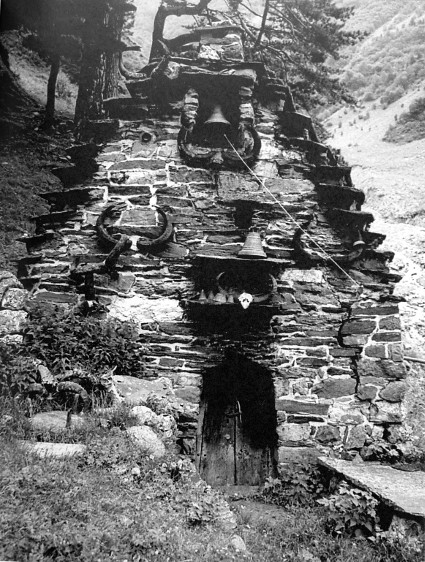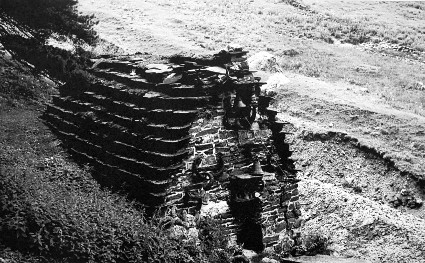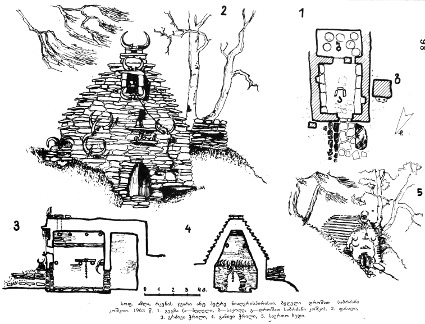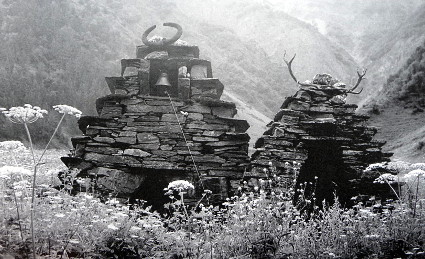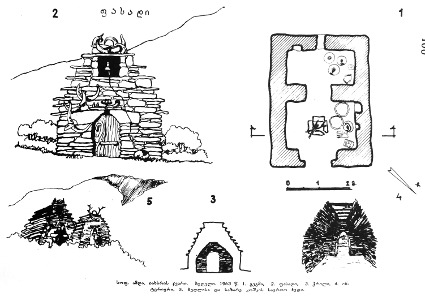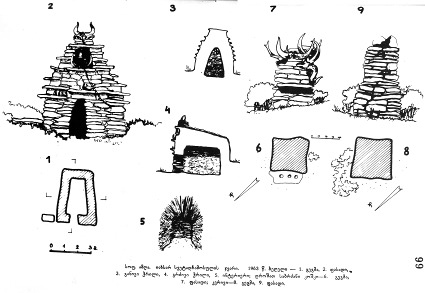Two shrines in Arkhoti
IAKHSAR DESCENDED-AS-A-PILLAR
&
RKENA / PETER THE APOSTLE OF THE TORRENT SPRING
Of all the shrines which dot the highlands of north-eastern Georgia (see this page for a complete list), perhaps the two most impressive ones are to be found near the village of Amgha in Arkhoti, the remotest region of Khevsureti, north of the main ridge of the Caucasus. They are the Supreme "Rkena" Cross (Peter the Apostle of the Torrent Spring) (Georgian: რკენისჯვარი (პეტრე ნიაღვრისპირისაი) ზეზეხატი) and Iakhsar Descended-as-a-pillar (სვეტისანგელოზის/იაჴსარ სვეტადჩამოსულის ჯვარი).
The following photographs and drawings were copied, respectively, from Shorena Kurtsikidze and Vakhtang Chikovani's brilliantly illustrated Ethnography and Folklore of the Georgia-Chechnya Border (Munich: LINCOM, 2008, plates 6, 7 and 8), and from volume II1 (Khevsureti) of Vera Bardavelidze's truly remarkable აღმოსავლეთ საქართველოს მთიანეთის ტრადიციული საზოგადოებრივ-საკულტო ძეგლები ("Traditional socio-religious monuments of the mountains of Eastern Georgia"; Tbilisi: Metsniereba, 1982, plates 98, 99 and 100). It is interesting to note the changes which have taken place between the year the drawings were made (1964) and that of the photographs (1977).
Among the wealth of detailed (if somewhat dry: almost exclusively architectural) information which Bardavelidze's book provides concerning these shrines, the inscriptions engraved onto the bells are perhaps the only items of truly human interest (my free translations):
—The 'Rkena' shrine (bell dated 1801):
|
ქ. ესე ზარი შევწირეთ სამწყალობელთა ჩვენ ქარჩანი შვილნი ბაფრამ მეორე ძმა უთურგიამ და იმათი ბიძაშვილები ჭრელია და ბეწუნა ამ ნიშნითა რომ რუსი დაამარცხა ომარ ხანს და მრავალი ლეკი დაიხოცა და ჩვენი უფროსი ძმა ელგუჯანი იწ მოკვდა ქ კს უფთ. |
C[hrist]. This bell we gave to our blesser, we the Karchani sons, Baphram, second brother Uturgia and their cousins Chrelia and Betsuna, for the reason that the Russians defeated Omar Khan and killed many Lesghians and our elder brother Elgujani died there [?k ks upt]. |
|---|
The defeat of Omar Khan is a reference to the 'Battle of Celery' (G. ნიახურის ბრძოლა), fought on the 7th of November 1800 near the village of Kakabeti on the right bank of the Iori river. The battle opposed a combined Georgian-Russian force and 20,000 Daghestani irregulars under Omar Khan. The latter, soundly defeated and badly injured, managed to flee but died of his wounds a few months later in Zakatala.
—The shrine of Iakhsar 'descended-as-a-pillar' (bell dated 1831):
|
ქ. ლაღი იაღსარი შემოგწირე ზარი არხოტიონმა მოკლიამ ხუმათ უფროსმა ახალა ერთზედ დამდგარმან შენ მოგვეც შენი საუკუნო მოწყალება და ჩვენც მტერზედ დამჯობინება ჩყიკა. |
C[hrist]. Proud Iakhsar, I, Moklia from Arkhoti, elder of the Khuma [clan or family], dedicated this bell to you, and now you decide and grant us your eternal blessing and victory over our enemies 1831 [N.B. 'ჩყიკა' = 1831]. |
|---|
(Many thanks to Kevin Tuite of the University of Montreal for his help with these translations.)
Makalatia's masterful Khevsureti (1935), however, contains these two fascinating paragraphs concerning the shrine of Iakhsar illustrated above (my free translation):
|
ამღაში ხუცეს წიკლაურის გვარიდან ირჩევენ და ხატობას მხვეწარს ის ამწყალობნებს. იახსარის ხატში ათენგენობას წინათ ქისტებიც მოდიოდენ თურმე, ქისტები ამ ხატს კვიცებს უკლავდენ და იახსარს ცხენების გამრავლებას შესთხოვდენ. დღეს კი იახსარის ხატს ამღელები "ს ა რ ე მ ა ო"-ს უხდიან. ამ მიზნით, როდესაც ცხენი კვიცს მოიგებს, ცხენის პატრონმა კვიცის მაგიერ იახსარს ციკანი ან ბატკანი უნდა დაუკლას, თორემ ხალხის რწმენით კვიცი არ გაიზრდება. იახსრის ხატს ლოცულობენ აგრეთვე გველისფერ წმ. გიორგობით. ხევსურების თქმით, ვისაც ამ ხატის მიზეზი გამოუვა, მას იახსარი გველის სახით მოეჩვენება და დამიზეზებულმა მას საკლავ-საწირი უნდა მიართვას და ილოცოს. თუ დამიზეზებულმა ამას ყურადღება არ მიაქცია, და გველმა მას სიზმარში მოჩვენებით უკბინა, მაშინ მას იახსარი ვერ უშველის და იგი მოკვდებაო. |
In Amgha, the khutsesi [shrine priest] is chosen from among the members of the Tsiklauri clan and blesses the congregation during shrine festivals. Every year, before the beginning of atengenoba [the main annual cycle of shrine festivals], even Kists paid homage to the shrine of Iakhsar. They would sacrifice foals and ask Iakhsar to multiply their herds. The inhabitants of Amgha to this day pay the s a r e m a o [an offering "for the herds of horses"] to the shrine. When a horse gives birth to a foal, its owner must sacrifice a goat-kid or a lamb to Iakhsar, else people believe the foal will not grow. St George the Snake-like [გველისფერ წმ. გიორგი] is also worshipped at the shrine of Iakhsar. The Khevsurs believe that Iakhsar appears as a serpent to all those whom the shrine chooses to concern, and that the latter must offer him a sacrifice and pray to him. If they omit to do so, and if the snake bites them in a dream, then Iakhsar will not save them and they die. |
|---|
Unless stated otherwise or obviously not the case, all the text and images on this website are © A.J.T. Bainbridge 2006-2017
Do get in touch! Gmail: alexjtb

